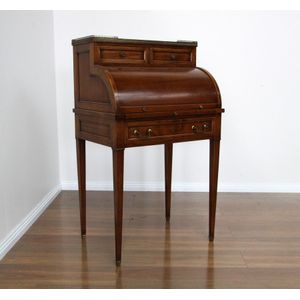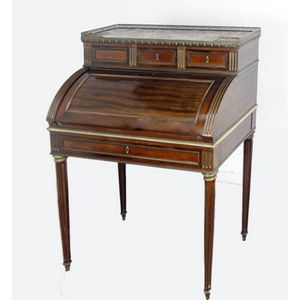Napoleon III Mahogany Bureau de Dame
You must be a subscriber, and be logged in to view price and dealer details.
Subscribe Now to view actual auction price for this item
When you subscribe, you have the option of setting the currency in which to display prices to $Au, $US, $NZ or Stg.
- Mahogany - Mahogany is a dense, close grained red-coloured timber from the West Indies and Central America. It was first imported into Europe in the the early 18th century and its use continued through the 19th century. It was popular for furniture making because of its strength, the wide boards available, the distinctive grain on some boards, termed flame mahogany and the rich warm colour of the timber when it was polished.. The "flame" was produced where a limb grew out from the trunk of the tree, and this timber was usually sliced into veneers for feature panels on doors, backs and cornices.
Some terms used to describe mahogany relate to the country from which it originally came, such as "Cuban" mahogany, "Honduras" mahogany etc. However unless the wood has been tested the names assigned are more a selling feature, rather than a true indication of the timber's origin. - Fluting - A form of decoration found on many pieces of furniture, as well as ceramics, silver and clocks, in which round-bottomed grooves, of varying width and depth, are let into columns, pilasters, legs. As a general rule, flutes are cut in the vertical, though they may follow a turned leg in a spiral pattern. In cross-section, they may be described as a series of 'U' shapes, rising and narrowing at each end of the groove. Fluting is the opposite of reeding, with which fluting is often associated.
- Gallery - On furniture, a gallery is a small upright section, frequently pierced and decorated, around the tops of small items of furniture, such as davenports, side tables, and so forth. Galleries are made in brass or bronze,and be fretted, pierced or solid timber. A three-quarter gallery is one that surrounds three of the four sides of a table, desk or other top.
This item has been included into following indexes:
-
desks, style or type
- bureau 374
- bureau de dame 21
Visually similar items

A Louis XV style gilt bronze mounted Boulle display table, 19th century, 74 cm high, 77 cm wide, 49 cm deep

A French walnut cylindrical roll top ladies writing desk on square tapered legs fitted with drawers. 108 cm high, 64 cm wide, 47 cm deep.

A French Louis XVI style 19th century bonheur du jour, the upper part with a pierced gallery, above three small drawers, and sliding cylinder, flanked by ormolu banding, above a hinged writing surface, above a long drawer, on turned tapering fluted legs. 1

A Napoleon III gilt bronze mounted kingwood, walnut and satinwood marquetry inlaid bureau a cylindre, 19th century, 108 cm high, 85 cm wide, 47 cm deep, Note: for a similar example see ' Ninteenth Century European Furniture ', Christopher Payne, Acc Art Bo
